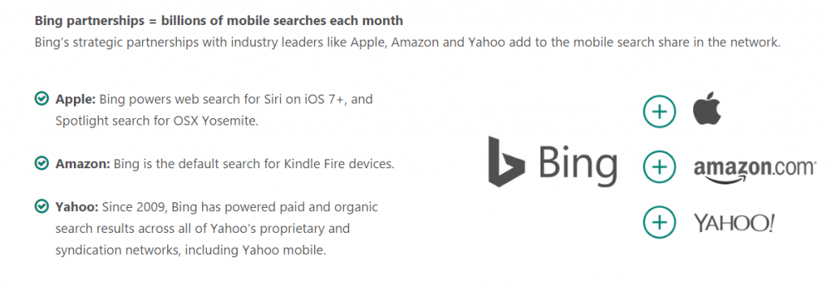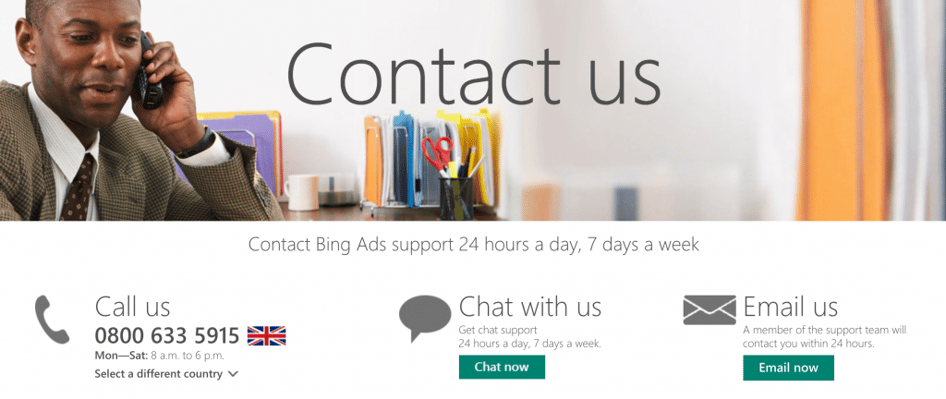Bing Ads, Microsoft’s answer to Google AdWords. The annoying cousin who’s always at family parties that you don’t really like. The search engine advertising you’ve wondered about exploring, but at the same time you’ve always been scared of investigating. Sounds familiar, right?
Or from an existing advertisers point of view, what about that client who says how well Google is working for them and that they don’t want to use any of their budget on something that might not work? Or those who say that no one uses Bing? Worse than that, you might just not fancy it. Afterall, it means creating a load of new work on a new platform, that everyone says is hard to navigate. Is it really worth it you ask yourself?
It doesn’t have to be this way. Change your way of thinking.
Here’s a few pointers that might have you rushing to Bing rather than avoiding it.
1. More Than 20% Market Share!
According to figures released in 2016, Bing now has more than 20% of the market share in the UK for web searches. You might think this isn’t much to shout about, but when you consider that there are billions of web searches done every day, more than 3.3 billion on Google alone, one in five searches is a pretty big deal. Great, but what does this mean for advertising? Well as obvious as it sounds, the more people using the search engine, the more likely you are to take an impression share and gain traffic. The growth of Windows 10 also plays an important factor in this; Bing is the default browser on all new PC’s and even has a built in desktop browsing facility, Cortana. Add to this the voice search available in Xbox One and the 200 million plus devices using Windows 10 and you soon realise why Bing are taking the market by storm. I actually spoke to a client about this recently, and we discussed that he’d recently bought a new laptop and that it’s default browser was Bing. We then discussed the likelihood of those who’d probably never change their browser, either because they’ve never bothered to or don’t know how to. A clever ploy from Microsoft, a very clever ploy indeed.

2. Bing is Cheap.
So far we’ve established that Bing are gaining market share, but what adds to their credibility is that it’s cheaper to advertise on than Google. Typically, using Bing for SEM is an afterthought. It’s a “we’ve exhausted AdWords, now what?” kind of situation. However, the guys at Search Engine Watch ran a study on campaigns that were identical in AdWords and Bing and found that overall it was cheaper to gain a conversion in Bing than AdWords by more than 63% (Read more about their study here). Again, what’s the reasoning behind this? Two things: less competition & cheaper CPC, the two go hand-in-hand. For example, I have a haulage client who uses both AdWords and Bing. They too have identical keywords, ads & Ad Groups on both platforms, and their Bing results show much cheaper CPC. In AdWords their cost per click is £0.79 whereas in Bing it’s £0.47. So this particular client has a cheaper CPC on Bing and a very similar CTR; both AdWords’ & Bing’s CTR is around 5%. I’d call that winning. Therefore, Bing can be a much more economical avenue for advertising than AdWords and an essential part of raising brand awareness and general SEM, so don’t let it be an afterthought, be proactive!
3. 59,000,000 Results Not On Google!
It has unique results. 59,000,000 unique results actually. Add to this the partner sites within the Bing network that include AOL, The Wall Street Journal & InfoSpace, you’ve got yourself a great niche of potential clientele, depending on whereabouts you are advertising. Factor into this that users who search the Bing Network spend 25% more than the average internet user and you begin to question why you had that bad attitude towards it in the first place. Let’s not pretend that it isn’t a bit clunky, and user experience isn’t great especially if you’re used to the innovative, easy-to-operate AdWords interface, however put this aside and think of the positives. Keep that glass half full, not half empty!

4. It’s Easy To Set Up.
No, really, it’s a piece of cake to implement your AdWords campaigns and bids into Bing Ads. As simple as one, two, three you could say. Firstly, within Bing you’ll see a tab called ‘Import Campaigns’. This little beauty allows you to essentially copy whole AdWords campaigns into Bing. Minimum input, maximum output. Once you’ve done this, select exactly what you want to import. This can be bids, budgets, ad extensions, the whole shebang if needed. Ideal, I think you’d agree? That was step two by the way. Last but not least, you’re ready to review your importations and get cracking. I have to say, the first time I did this I thought it was pretty epic and extremely time-effective.
5. Superb Support.
Finally, as a Google Premier Partner we love our Google account strategists and support team, however Bing offer a great support network too. You can call them or chat online, both of which are easy to use and what’s great is that their support team give you pointers and opportunities of how you can take your account forward. That doesn’t mean Google don’t, but it’s always nice to know that they’re looking out for you and your account and trying to better the performance and optimisation.
So it’s cheaper, it has a unique audience and unique results and it’s on the march in terms of market share; so why haven’t you tried Bing Ads yet? Okay so it might not be as nice to use as AdWords, and you’re not guaranteed success just because it’s typically cheaper to advertise on, but it’s definitely worth thinking about, whether you’re an existing advertiser or are on the cusp of dipping your toes into the world of online paid search.
Despite having a smaller market share than Google, Bing certainly has the potential to bring you similar or even better results than what you can experience on AdWords. So go on, show Bing some love this Valentine’s Day!

[contact-form-7 404 "Not Found"]
Tags:
February 8, 2017